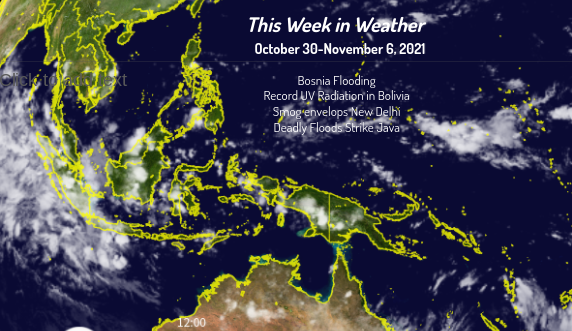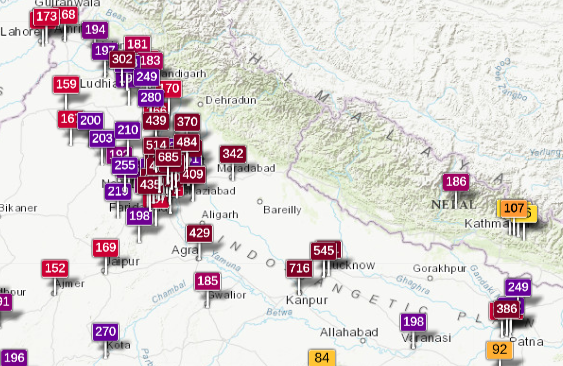This Week In Weather – October 31 to November 6, 2021

Bosnia Flooding

Severe flash flooding caused by heavy rains following warm weather has hit parts of Bosnia on Friday. The capital of the country – Sarajevo had been left without power for hours. The flooding prompted evacuations and school cancelations. Hundreds of homes in the suburbs of the capital along the rivers Bosnia, Tilava, and Zeljeznica and in the southwest part of the country, around Konjic, had been evacuated due to non-stop heavy downpours. “Everything is underwater … The situation is bad and we do not expect it to improve soon,” said a firefighter coordinating evacuations. The only certified medical oxygen-refilling plant in the country, part of the German Messer Group, was evacuated after it flooded. “We could not save the equipment,” Avdo Delic, the general manager of Messer’s branch in Bosnia, told reporters [1]. Delic expressed concerns that Bosnian hospitals could run out of oxygen cylinders to treat COVID-19 patients unless the operations are restored elsewhere. Rain started late on Thursday and forecasts say it will continue to fall until Sunday.
Record High UV Radiation Recorded in Bolivia
Bolivian city of La Paz has been hit by an unusual heatwave, with levels of ultraviolet (UV) radiation going off the charts, exacerbated by unusually low levels of cloud cover. UV radiation levels reached as high as 21 on a scale that normally only goes up as high as 20. According to the World Health Organization, a UV Index of 11 is regarded as “extreme,” with people cautioned to avoid exposure to the sun.
“It isn’t normal,” say citizens trying to cool themselves by eating shaved ice and keeping to the shadows. “This is an issue that has literally had La Paz cooking,” said Juan Pablo Palma, a risk management official in the municipality. [2] “Rainy seasons can bring the same amount of rain but it’s getting shorter,” said Luis Blacutt, a researcher at the atmospheric physics laboratory in La Paz.
Smog Covers Skies of New Delhi, Beijing
Residents of the capital of India woke up under a blanket of smog after Diwali revelers defied a fireworks ban during India’s annual Hindu festival of lights. The Air Quality Index (AQI) surged to 463 on a scale of 500, indicating “severe” conditions. “The firecracker ban didn’t seem to be successful,” said Sunil Dahiya, an analyst at the Center for Research on Energy and Clean Air (CREA) as pollution reached hazardous levels [3]. In Delhi, a city of about 20 million people, PM2.5 levels on Friday averaged 706 micrograms per cubic meter of air. The World Health Organization deems anything above 5 micrograms as unsafe.

Adding to the annual festival of lights, in the Indian states of Punjab and Haryana that set their fields on fire for them to quickly clear it. Reasons that smoke reaches the country’s capital are the Himalayas acting as natural barriers and the cold mountain air rushing southeastward. The warm air keeps pollution trapped on the ground with nowhere to go, and as the fire smoke arrives in Delhi, it mixes with the urban pollution forming toxic smog covering the city.
Meanwhile in China, visibility in parts of Beijing was less than 200 meters on Friday, forcing the closure of some highways. The PM2.5 level reached as high as 234 micrograms per cubic meter on Friday. The smog severely limited that city’s tallest buildings vanishing in the haze. The heavily industrialized Beijing-Tianjin-Hebei region often suffers from heavy smog in the fall and winter, especially on days without wind. A cold wave coming from Siberia over the weekend is expected to disperse the pollution.
Ads by 
Deadly Floods Strike Java
Rescuers scrambled on Friday to find survivors under hillsides after flash floods on Java island killed at least eight people, according to the disaster agency. Torrential rains on Thursday and Friday caused flash floods in the towns of Malang and Batu, inundating houses with mud and debris, while the floodwater destroyed bridges. Six people were pulled alive, while rescuers found six bodies in Batu and two more in Malang. Rescue teams continue to find more people unaccounted in Batu, said Abdul Muhari [4], spokesperson of Indonesia’s National Disaster Mitigation Agency. Ganip Warsito, the agency chief, said that heavy rains across the country are expected to continue and increase until February, partly because of La Niña.
[1] (www.dw.com), Deutsche Welle. “Flash Flooding Wreaks Havoc in Bosnia: DW: 05.11.2021.” DW.COM, Deutsche Welle, 5 Nov. 2021, https://www.dw.com/en/flash-flooding-wreaks-havoc-in-bosnia/a-59737920.
[2] Reuters, Story by. “’This Sun Isn’t Normal’: Extreme UV Radiation Is Broiling Bolivia’s Highlands.” CNN, Cable News Network, 3 Nov. 2021, https://www.cnn.com/2021/11/03/americas/bolivia-heatwave-highlands-intl/index.html.
[3] Reuters. “Diwali Leaves New Delhi Wheezing in Dangerously Unhealthy Air.” NBCNews.com, NBCUniversal News Group, 5 Nov. 2021, https://www.nbcnews.com/news/world/diwali-leaves-new-delhi-wheezing-dangerously-unhealthy-air-n1283309.